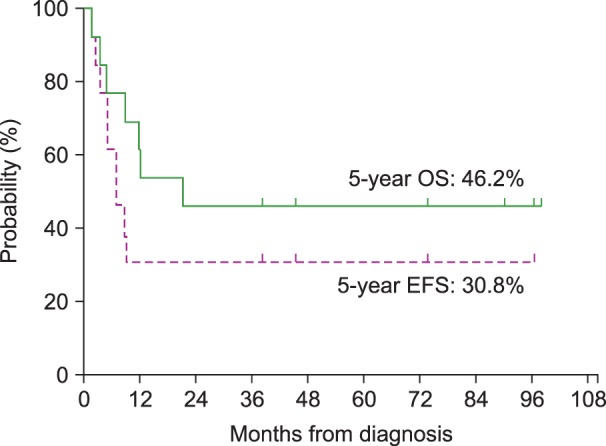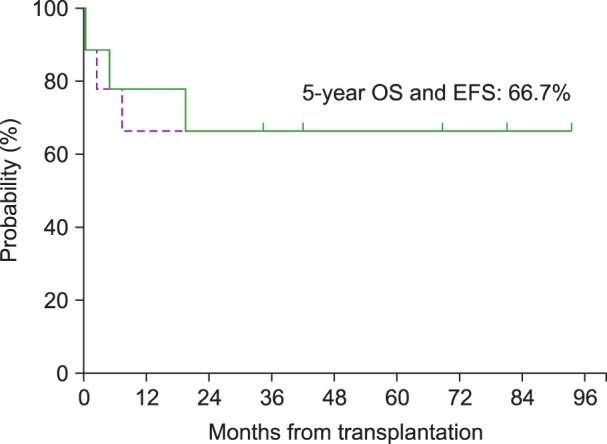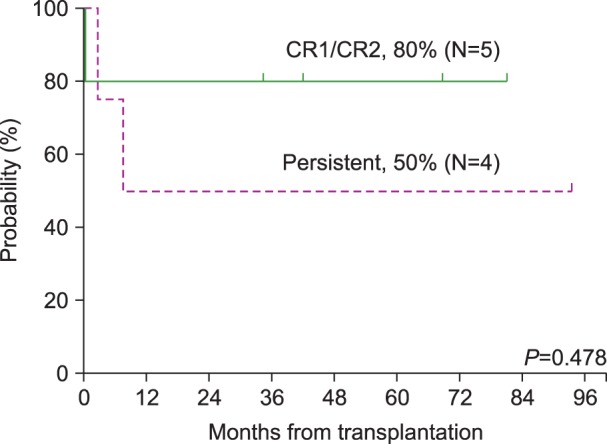Blood Res.
2016 Dec;51(4):242-248. 10.5045/br.2016.51.4.242.
Therapy-related myeloid neoplasms in children and adolescents
- Affiliations
-
- 1Department of Pediatrics, Samsung Medical Center, Sungkyunkwan University School of Medicine, Seoul, Korea. hema2170@skku.edu
- 2Department of Pediatrics, Chung-Ang University Hospital, Seoul, Korea.
- 3Department of Medical Device Management and Research, SAIHST, Sungkyunkwan University, Seoul, Korea.
- KMID: 2364314
- DOI: http://doi.org/10.5045/br.2016.51.4.242
Abstract
- BACKGROUND
This retrospective study aimed to characterize and analyze the outcome of therapy-related myeloid neoplasms (t-MNs) in children and adolescents.
METHODS
The medical records of 16 patients under 21 years of age at the time of t-MN diagnosis were reviewed.
RESULTS
The median patient age was 11.5 years (range, 1.6-20.4 yr). Twelve patients had therapy-related acute myeloid leukemia, 3 patients had myelodysplastic syndrome, and 1 patient had chronic myelomonocytic leukemia. The median latency period was 29 months (range, 11-68 mo). Fourteen patients had cytogenetic aberrations, 8 of whom had an 11q23 abnormality. Of the 13 patients treated with curative intent, 12 patients received myeloid-type induction therapy that led to complete remission (CR) in 8 patients. Nine patients underwent allogeneic transplantation; 4 patients did not undergo transplantation due to chemotherapy-related toxic death (N=3) or parental refusal (N=1). The 5-year overall survival and event-free survival of the 13 patients treated with a curative intent were 46.2% and 30.8%, respectively. For the 9 patients who underwent allogeneic transplantation, the 5-year event-free survival was 66.7%.
CONCLUSION
A significant proportion of young patients with t-MNs can experience long-term survival, and allogeneic transplantation plays a key role for attaining cure in these patients.
Keyword
MeSH Terms
Figure
Reference
-
1. Ng AK, Travis LB. Subsequent malignant neoplasms in cancer survivors. Cancer J. 2008; 14:429–434. PMID: 19060610.
Article2. Vardiman JW, Thiele J, Arber DA, et al. The 2008 revision of the World Health Organization (WHO) classification of myeloid neoplasms and acute leukemia: rationale and important changes. Blood. 2009; 114:937–951. PMID: 19357394.
Article3. Smith SM, Le Beau MM, Huo D, et al. Clinical-cytogenetic associations in 306 patients with therapy-related myelodysplasia and myeloid leukemia: the University of Chicago series. Blood. 2003; 102:43–52. PMID: 12623843.
Article4. Godley LA, Larson RA. Therapy-related myeloid leukemia. Semin Oncol. 2008; 35:418–429. PMID: 18692692.
Article5. Larson RA. Therapy-related myeloid neoplasms. Haematologica. 2009; 94:454–459. PMID: 19336749.
Article6. Leone G, Fianchi L, Pagano L, Voso MT. Incidence and susceptibility to therapy-related myeloid neoplasms. Chem Biol Interact. 2010; 184:39–45. PMID: 20026017.
Article7. Kayser S, Döhner K, Krauter J, et al. The impact of therapy-related acute myeloid leukemia (AML) on outcome in 2853 adult patients with newly diagnosed AML. Blood. 2011; 117:2137–2145. PMID: 21127174.
Article8. Hale GA, Heslop HE, Bowman LC, et al. Bone marrow transplantation for therapy-induced acute myeloid leukemia in children with previous lymphoid malignancies. Bone Marrow Transplant. 1999; 24:735–739. PMID: 10516676.
Article9. Woodard P, Barfield R, Hale G, et al. Outcome of hematopoietic stem cell transplantation for pediatric patients with therapy-related acute myeloid leukemia or myelodysplastic syndrome. Pediatr Blood Cancer. 2006; 47:931–935. PMID: 16155933.
Article10. Aguilera DG, Vaklavas C, Tsimberidou AM, Wen S, Medeiros LJ, Corey SJ. Pediatric therapy-related myelodysplastic syndrome/acute myeloid leukemia: the MD Anderson Cancer Center experience. J Pediatr Hematol Oncol. 2009; 31:803–811. PMID: 19801947.11. McGowan-Jordan J, Simons A, Schmid M, editors. ISCN 2016: An International System for Human Cytogenomic Nomenclature (2016). Basel, Switzerland: S. Karger;2016.12. Tucker MA, Meadows AT, Boice JD Jr, et al. Leukemia after therapy with alkylating agents for childhood cancer. J Natl Cancer Inst. 1987; 78:459–464. PMID: 3469460.13. Meadows AT, Obringer AC, Marrero O, et al. Second malignant neoplasms following childhood Hodgkin's disease: treatment and splenectomy as risk factors. Med Pediatr Oncol. 1989; 17:477–484. PMID: 2586362.
Article14. Janeway KA, Place AE, Kieran MW, Harris MH. Future of clinical genomics in pediatric oncology. J Clin Oncol. 2013; 31:1893–1903. PMID: 23589558.
Article15. Smith MA, Seibel NL, Altekruse SF, et al. Outcomes for children and adolescents with cancer: challenges for the twenty-first century. J Clin Oncol. 2010; 28:2625–2634. PMID: 20404250.
Article16. Barnard DR, Lange B, Alonzo TA, et al. Acute myeloid leukemia and myelodysplastic syndrome in children treated for cancer: comparison with primary presentation. Blood. 2002; 100:427–434. PMID: 12091332.
Article17. Larson RA. Etiology and management of therapy-related myeloid leukemia. Hematology Am Soc Hematol Educ Program. 2007; 453–459. PMID: 18024664.
Article18. Churpek JE, Larson RA. The evolving challenge of therapy-related myeloid neoplasms. Best Pract Res Clin Haematol. 2013; 26:309–317. PMID: 24507808.
Article19. Yakoub-Agha I, de La Salmonière P, Ribaud P, et al. Allogeneic bone marrow transplantation for therapy-related myelodysplastic syndrome and acute myeloid leukemia: a long-term study of 70 patients-report of the French Society of Bone Marrow Transplantation. J Clin Oncol. 2000; 18:963–971. PMID: 10694545.
Article20. Litzow MR, Tarima S, Pérez WS, et al. Allogeneic transplantation for therapy-related myelodysplastic syndrome and acute myeloid leukemia. Blood. 2010; 115:1850–1857. PMID: 20032503.21. van den Berg H. Treatment related myeloid malignancies in childhood. Hematol Leuk. 2014; 2:3.
Article




